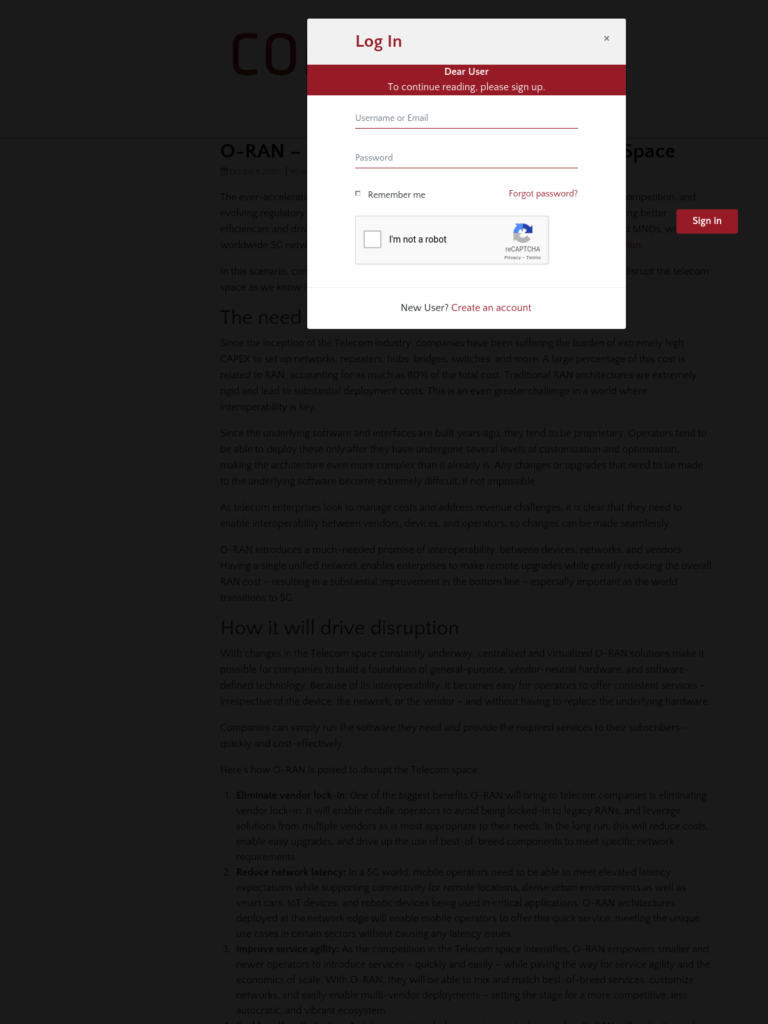O-RAN – How It Would Disrupt the Telecom Space
Blog: NASSCOM Official Blog
The ever-accelerating pace of change in technology advancement, market trends, growing competition, and evolving regulatory requirements is putting immense pressure on telecom companies. Creating better efficiencies and driving enhanced value has become an imperative for telecom operators and MNOs, with the worldwide 5G network infrastructure market revenue expected to double in 2020 to $8.1 billion.
In this scenario, concepts like Open-Radio Access Network or O-RAN have the potential to disrupt the telecom space as we know it.
The need for O-RAN
Since the inception of the Telecom industry, companies have been suffering the burden of extremely high CAPEX to set up networks, repeaters, hubs, bridges, switches, and more. A large percentage of this cost is related to RAN, accounting for as much as 80% of the total cost. Traditional RAN architectures are extremely rigid and lead to substantial deployment costs. This is an even greater challenge in a world where interoperability is key.
Since the underlying software and interfaces are built years ago, they tend to be proprietary. Operators tend to be able to deploy these only after they have undergone several levels of customization and optimization, making the architecture even more complex than it already is. Any changes or upgrades that need to be made to the underlying software become extremely difficult, if not impossible.
As telecom enterprises look to manage costs and address revenue challenges, it is clear that they need to enable interoperability between vendors, devices, and operators, so changes can be made seamlessly.
O-RAN introduces a much-needed promise of interoperability, between devices, networks, and vendors. Having a single unified network enables enterprises to make remote upgrades while greatly reducing the overall RAN cost – resulting in a substantial improvement in the bottom line – especially important as the world transitions to 5G.
How it will drive disruption
With changes in the Telecom space constantly underway, centralized and virtualized O-RAN solutions make it possible for companies to build a foundation of general-purpose, vendor-neutral hardware, and software-defined technology. Because of its interoperability, it becomes easy for operators to offer consistent services – irrespective of the device, the network, or the vendor – and without having to replace the underlying hardware.
Companies can simply run the software they need and provide the required services to their subscribers – quickly and cost-effectively.
Here’s how O-RAN is poised to disrupt the Telecom space:
- Eliminate vendor lock-in: One of the biggest benefits O-RAN will bring to telecom companies is eliminating vendor lock-in. It will enable mobile operators to avoid being locked-in to legacy RANs, and leverage solutions from multiple vendors as is most appropriate to their needs. In the long run, this will reduce costs, enable easy upgrades, and drive up the use of best-of-breed components to meet specific network requirements.
- Reduce network latency: In a 5G world, mobile operators need to be able to meet elevated latency expectations while supporting connectivity for remote locations, dense urban environments as well as smart cars, IoT devices, and robotic devices being used in critical applications. O-RAN architectures deployed at the network edge will enable mobile operators to offer this quick service, meeting the unique use cases in certain sectors without causing any latency issues.
- Improve service agility: As the competition in the Telecom space intensifies, O-RAN empowers smaller and newer operators to introduce services – quickly and easily – while paving the way for service agility and the economics of scale. With O-RAN, they will be able to mix and match best-of-breed services, customize networks, and easily enable multi-vendor deployments – setting the stage for a more competitive, less autocratic, and vibrant ecosystem.
- Enable self-optimization: As telecom networks become increasingly complex, O-RAN will make it easy for operators to deploy, operate, and optimize networks. By leveraging intelligent technologies, O-RAN solutions will be able to automate operational network functions. This can be achieved through dynamic resource allocation and optimized network-wide efficiency in a self-driven manner – reducing the manual stress of optimization while improving the service quality.
- Ensure regulatory compliance: Modern O-RAN solutions are designed keeping in mind the requirements of next-generation RAN infrastructures. Built using the principles of intelligence and openness as well as industry regulations and standards, they support well-defined, standardized interfaces. And they do that while enabling an open, interoperable ecosystem.
- Keep up with demand: As the demand for data increases, networks must also evolve accordingly. O-RAN solutions help overcome the challenge of scaling and upgrading current telecom network infrastructures, enabling vendors and operators to keep up with increasing network demand. By decoupling the underlying hardware and software, it provides vendors with more flexibility to deploy and upgrade network infrastructure across different deployment scenarios and geographies.
In a world where telecom operators have been struggling to break free from the legacy architectures they’ve been tied to, O-RAN helps them in easily and confidently circumventing the complexities of traditional networks. By enabling seamless interoperability and creating a platform that brings together solutions from multiple vendors, O-RAN is what the Telecom industry needs to scale and sustain next-gen technologies.
Source: https://blog.calsoftinc.com/2020/10/o-ran-how-it-would-disrupt-the-telecom-space.html
The post O-RAN – How It Would Disrupt the Telecom Space appeared first on NASSCOM Community |The Official Community of Indian IT Industry.
Leave a Comment
You must be logged in to post a comment.








